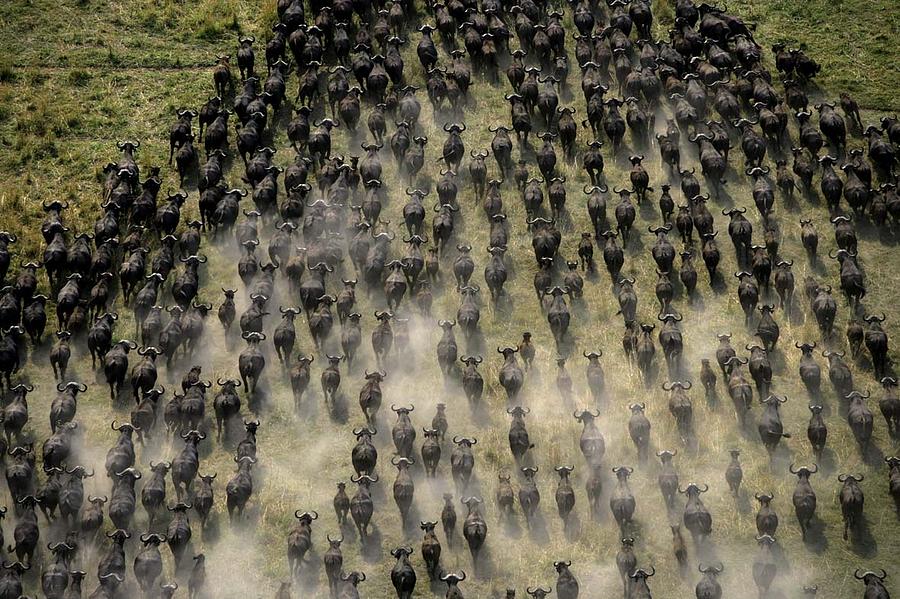The Herd Mentality That’s Actually Rather Democratic

Pictured above is a herd of African buffalo, all marching off to somewhere or another. Wherever they’re going, one thing is clear: they’re all going in the same direction. If you’ve heard the term “herd mentality,” this seems to be an example — a few of the buffalo get up to go somewhere, and the vast majority of the rest are mindlessly following the leader, not quite sure where they’re going or why.
And while that’s probably mostly true in the above photo, it didn’t start out that way. The buffalo didn’t just randomly set off in the direction that the first mover. More likely than not, they actually voted to decide where to go.
Well, the women did.
For years, a researcher named Herbert Prins observed the habits of herds of African buffalo, particularly in the region of Lake Manyara in Tanzania. (Here’s a map.) In 1996, as another researcher, David Sloan Wilson would recount in a subsequent paper (pdf here), Prins noticed that the buffalos tended to stretch a lot. After two years of viewing what Wilson described as “a mundane stretching activity,” Prins noticed that there was more happening than he originally thought. The buffalo weren’t waking up from a short nap — they were talking to one another in a weird form of sign language. Prins explains:
Some buffalo cows arise, shuffle around a bit and bed down again. At first I interpreted this as ‘‘stretching the legs,’’ but one day I noticed that the cows adopt a particular stance after the shuffling and before lying down again. They seem to gaze in one direction and keep their head higher than the normal resting position but lower than the alert. . . . This standing up, gazing and lying down behaviour continues for about an hour, but the overall impression remains that of a herd totally at rest. Then at about 18.00 hours there is a sudden energizing of the herd. . . . A few moments later, everywhere in the herd buffalo start trekking. The exciting thing is that they start trekking, at the beginning independently of each other, in the same direction. Within seconds, the animals that initiate these movements are followed by other individuals, clusters of movement arise, and within about 3–5 minutes the whole herd of hundreds of individuals moves as if conducted by one master. They totally give the impression that they know where they are going to: apparently, some decision has been taken in the group.
In essence, Prins concluded, the “stretching” was an example of animals acting democratically — the buffalo were voting on where to go next. But not all of the buffalo get to vote. As Wilson explains, “Only adult females vote, and females participate regardless of their social status within the herd.” The male buffalo, it seems, just go with whatever the females decide. And they’re not electing a leader, either; per the study, “there is no evidence for individual leadership;” rather, each day’s decision as to where to graze next is determined by the majority view on that day.
The voting buffalo phenomenon isn’t localized to African buffalo, either. In 2016, Scientific American reported on similar behavior exhibited by European buffalo observed in the south of France:
If they want to graze in a meadow, they face the meadow. If they would rather slake their thirst, they turn toward a water hole. Eventually, one bison makes a move. If the initiator advances in the direction preferred by most herd members, the group follows. If the initiator chooses a less popular option, few follow, and the group might split for a brief period. Anyone can initiate a movement, although adult females typically garner the largest number of followers. In essence, the initiator with the most votes wins and ends up leading most of the herd.
So while in the end, most of the animals are just following the direction set by a few, the masses aren’t entirely powerless to decide where to go. And even if they didn’t get their way one day, each new day brings a new election.
Bonus fact: The flag of Wyoming, seen here, has an American buffalo as a main part of the design. On the flag typically used today, the buffalo faces the flagpole side of the flag, as seen in that image. But that wasn’t always the case. The original flag design, seen here, had the buffalo facing the other way until a Wyoming scholar named Grace Raymond Hebard pointed out that animals, including buffalo, tend to face into the wind, and as a result, are almost always depicted on flags facing into the flagpole. Wyoming’s flag adoption statute doesn’t specify which direction the buffalo is supposed to face, so state flagmakers simply adopted Hebard’s suggestion, making it the de facto official version.
From the Archives: The Longest One-Word Sentence?: “Buffalo buffalo Buffalo buffalo buffalo buffalo Buffalo buffalo” is a valid sentence, which is ridiculous.
